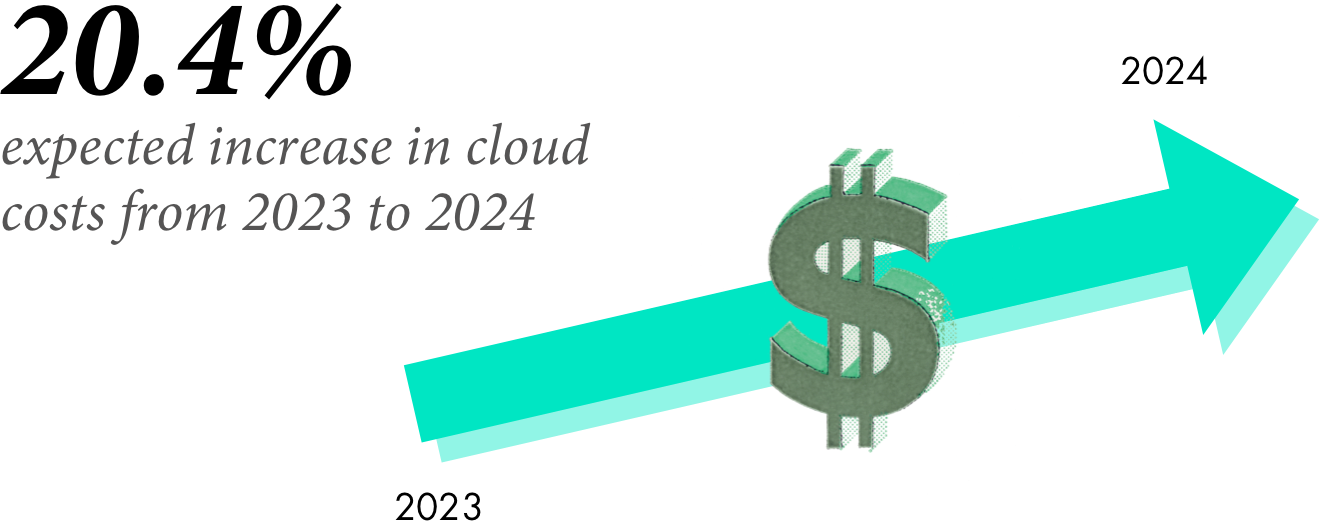What issue can we solve for you?
Type in your prompt above or try one of these suggestions
Suggested Prompt



Say Goodbye to Cloud Sticker Shock, with FinOps
Say Goodbye to Cloud Sticker Shock, with FinOps
Organizations moving to the cloud often assume their operational expense will automatically come down. This anticipation is driven by the alluring promise of cost-efficiency, scalability and elasticity. But without an in-depth understanding of different cloud cost units, meticulous planning and continuous cost monitoring, costs can exceed expectations without your organization knowing why.
Cloud FinOps, short for financial operations, is becoming a boardroom topic. According to a Gartner forecast, cloud costs are expected to rise 20.4 percent from 2023 to 2024,¹ directly affecting the bottom line. Our studies show that 64 percent of businesses with mature cloud programs cite cloud cost optimization as their top initiative, aiming to understand the cost breakout so they can control costs. Two in three CIOs in an IDC poll² said that cloud expenses exceeded budget, and more than half of CEOs expressed concern over unmanaged cloud costs.

Top reasons for unexpected cloud costs
Cloud billing is metered, which is also known as usage-based or consumption-based. Bills reflect usage for every element of cloud infrastructure, and even for data transfer between machines in the same region. Therefore, optimizing cloud finances starts with an in-depth understanding of how your organization uses cloud resources and the origin of every expense component.

Ready to take your cloud journey to the next level?
Head over to our dedicated cloud modernization landing page to chart your modernization journey.
A key reason for unexpected cloud costs is limited governance. We have observed that many businesses have only a rudimentary notion of how cloud resources are managed and billed. If this applies to your business, you might be paying for more processing power than required, for example, or not taking advantage of storage tiering to automatically move data between high-cost and low-cost storage media based on how often the data is accessed. Organizations that do have clear cloud usage policies often don’t have the guardrails to enforce them, such as enforced quotas or automated workload shutdown when not needed. Unexpected costs usually aren’t discovered until the end of the billing period—too late to change course.
Another source of higher-than-necessary cloud costs is a limited understanding of cloud architecture and how to take advantage of it. For example, legacy software applications use resources less efficiently than cloud-native architectures based on microservices and APIs. Cloud capabilities, such as auto-scaling and certain disaster recovery configurations, can also reduce costs compared to legacy techniques used in the data center.
Cloud FinOps is about cost optimization, not cost cutting
FinOps is an operational framework to optimize cloud finances by making data-driven decisions about cloud infrastructure, contracts and managing the bottom line. It supersedes yesterday’s CapEx approaches to financial management. The number of companies adopting a FinOps framework doubled from 2021 to 20233. However, we find that few of these companies take full advantage of the potential of FinOps.
A common misunderstanding is that FinOps is strictly about reducing cloud spend. That’s shortsighted. Mandating the use of less-expensive cloud processors, for example, is a poor business decision if it degrades the user experience or delays the introduction of a new machine learning model to cut supply chain costs. FinOps is intended to optimize cloud spend to achieve business goals. The idea is to realize the value of cloud, which is not cheap infrastructure but rather the flexibility and infinite scalability to meet business demand.
FinOps is intended to optimize cloud spend to achieve business goals. The idea is to realize the value of cloud, which is not cheap infrastructure but rather the flexibility and infinite scalability to meet business demand.
Successful cloud FinOps requires viewing cloud finances through both a business and strategic lens, embedding it into every aspect of cloud operations. The IT team and CFO’s organization cannot work in isolation. The IT team should know the service per unit costs for each department and the extent of cost variation and plan capacity accordingly. The finance team needs to collect this data from the IT team to establish the budget. In our experience, cloud FinOps succeeds when it’s a collaborative effort between cloud architects, the IT team responsible for cloud operations and management, finance and procurement team.

Ready to take your cloud journey to the next level?
Head over to our dedicated cloud modernization landing page to unlock the full potential of cloud for your organization with downloadable resources.
Key principles of an effective cloud FinOps strategy:
-
![]()
Set up a cloud FinOps function
Include members from the IT team, finance and operations management. Consider including a FinOps practitioner, finance executives, product owners, engineering leads and procurement.
![]()
Take a top-down approach to cloud expenses
Map every category of cloud expense to its business value, making sure that no cost is stranded.
![]()
Embed cloud FinOps into every aspect of cloud operations
Form a habit of constantly looking for new ways to optimize costs—for example, with performance benchmarking, granular cost allocation for capacity planning, understanding resource utilization, collaborating with different stakeholders and so on.
![]()
Develop a cloud responsibility matrix.
Assign teams and individuals to be accountable for operations, management and escalations.
![]()
Establish a practice of continuous evaluation
Regularly reassess plans based on capacity, demand and resource usage.
How can Publicis Sapient help?
Publicis Sapient helps organizations throughout their cloud cost optimization journey by taking a phased approach. We work with you to understand the business context, identify stakeholders and data sources, measure performance (actual costs versus forecast) and optimize resource utilization. To help you advance to the next level of cloud maturity, we continually look for new opportunities for automation and process reengineering. Learn more about how you can take control of your cloud finances in our Publicis Sapient Cloud Cost Management guide.
References
1. Gartner Forecasts Worldwide Public Cloud End-User Spending to reach USD 679 BN in 2024, Gartner, November 13, 2023
2. Five Cost Management Tips for IT Leaders, IDC. April 21, 2023
Related reading
-
![open laptop with clouds on the screen and in the background]()
Your Guide to Cloud Cost Management
Unlock the full potential of cloud cost management with our playbook. Download it today to learn how to cut costs, gain predictability and lead confidently in the digital era.
-
![white and blue geometric-shaped clouds on top of a tablet screen]()
Cloud & Infrastructure Solutions
Rely on end-to-end integration services to define the strategy, platform and architecture necessary for seamless, scalable and secure cloud migration.
-
![padlock floating in a cloud suspended in a clear glass encasement]()
Fortifying Cloud Security: The Power of Zero Trust
Embrace cloud-native security practices and zero trust principles to align your security framework with the dynamic nature of cloud environments.











